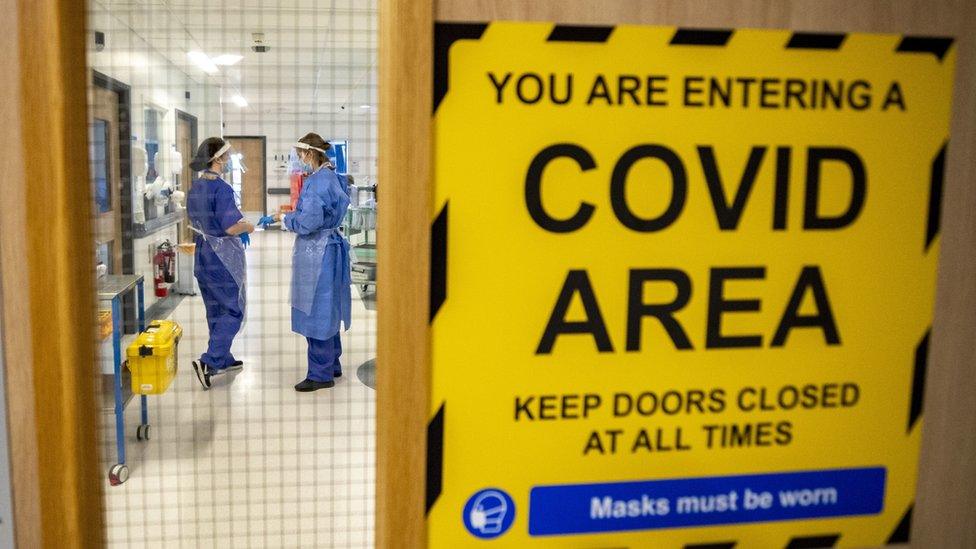Covid-19: NI's vaccination programme success continues
- Published

Almost half of all adults in Northern Ireland have had a vaccine dose
Looking at the numbers associated with coronavirus in Northern Ireland, the picture continues to improve.
The death rate has fallen to its lowest point for almost six months; the number of people in hospital is still decreasing, albeit slowly; and almost half of all adults in Northern Ireland have had a vaccine dose.
Vaccinations
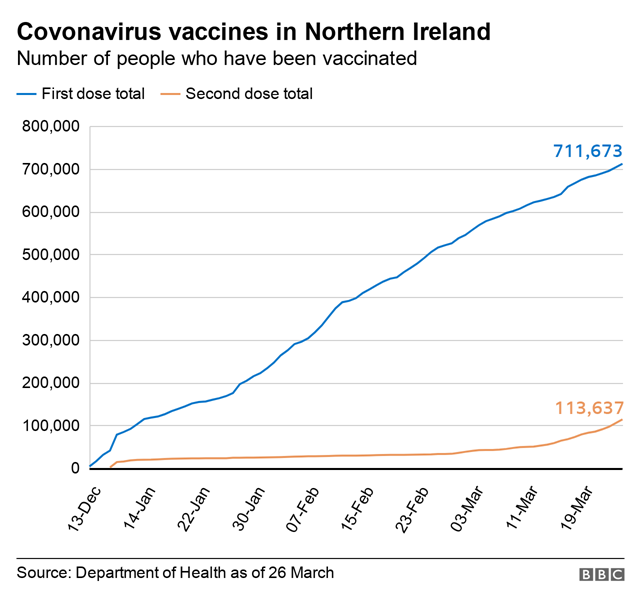

Northern Ireland's vaccination programme has been - and continues to be - a success.
Vaccines are crucial to hopes of a return to normal life and compared to most places in the world, Northern Ireland is in very good shape.
The latest figures show 711,673 people here have had a vaccine jab. That's about 38% of the overall population, and just shy of 50% of the adult population.
By any measure, that's impressive.
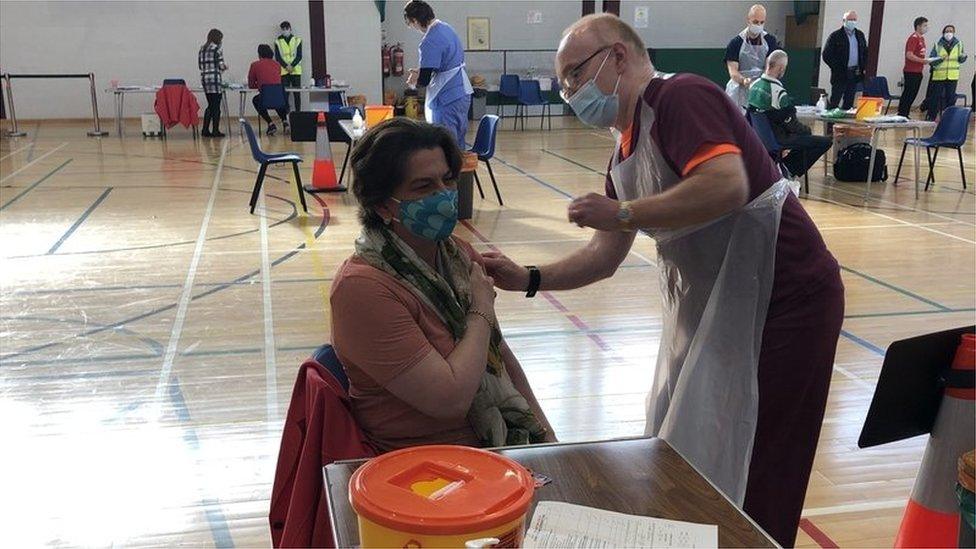
NI First Minister Arlene Foster received her first AstraZeneca jab on Saturday
On Saturday, Northern Ireland's first minister received her first dose of a Covid-19 vaccine.
Arlene Foster received an AstraZeneca jab by a GP at the Castle Park leisure centre in Lisnaskea in County Fermanagh.


Northern Ireland remains a little behind the other nations in the UK in terms of percentage of the population vaccinated. And that gap has been growing.
The Republic of Ireland is similar to much of the EU, which lags considerably behind the UK at the moment.
The percentages of populations vaccinated so far for the UK and Ireland are as follows:
UK - 44.2%
England - 44.6%
Scotland - 43.0%
Wales - 42.9%
Northern Ireland - 38.0%
Republic of Ireland - 10.3%
Northern Ireland's speed of delivery of first doses has slowed a little but this can be explained by the fact more second doses are now being administered than before.
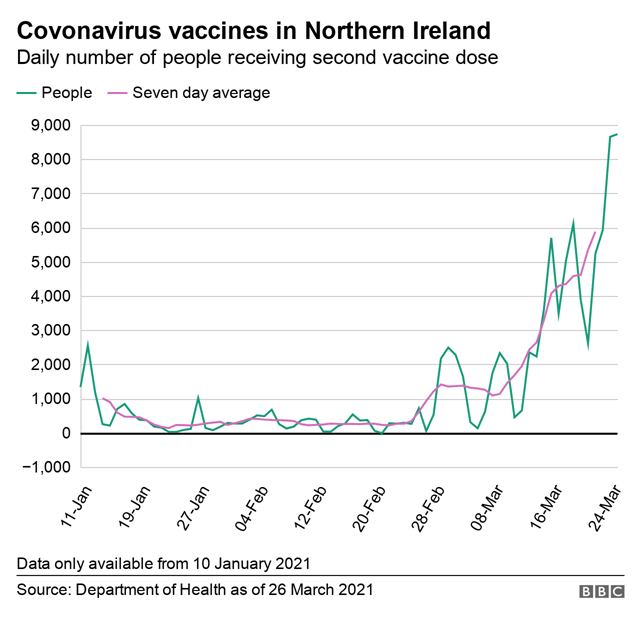

Over the past week - and on average - about 6,500 people received their first dose of vaccine per day.
The equivalent figure for second doses was about 7,100. It's the first time the rolling average for second doses has been higher than for first doses.
But this is hardly surprising, as the people who were in the top priority groups for the vaccine are now due their second dose.
Vaccination uptake
OK, this next bit comes with a warning - by the author's own admission, the numbers below do not reflect the full reality of uptake of vaccinations in Northern Ireland.
Rather, it's a best attempt with the available figures.
Despite making more data about the vaccination programme available in recent weeks, the Department of Health does not yet publish levels of uptake of the vaccine on its new dashboard.
However, by using population data published by Nisra, it is possible to gain a very basic insight into uptake levels - specifically among the age groups eligible to receive the vaccine.
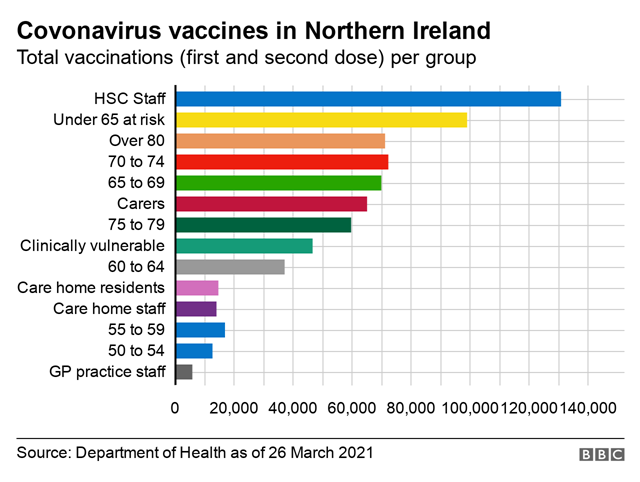

Nisra's mid-year population estimates helpfully include population numbers by age.
This means we can find out how many people are thought to be in each vaccine-eligible age group - 80+; 74-79; 70-75 and so on.
Taking these figures, and comparing them to the numbers published for each age group on the department's vaccination dashboard, means we can get an estimated percentage of vaccine uptake in each of the following age groups:
80 and over - at least 87% vaccinated
75-79 - at least 96% vaccinated
70-74 - at least 89% vaccinated
65-69 - at least 78% vaccinated
60-64 - at least 35% vaccinated
55-59 - at least 13% vaccinated
50-54 - at least 10% vaccinated
It should be emphasised, however, that these rates are in no way definitive and the actual percentage will be higher in each age bracket.
Consider these rates to be a best guess in the absence of uptake rates being published by the Department of Health.
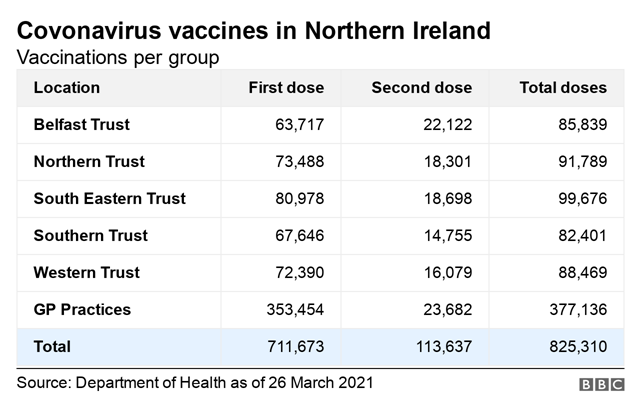

The reason the real rates will undoubtedly be higher is that many people can qualify for a vaccine in numerous ways.
For example, someone could be a 57-year-old healthcare worker, who also happens to be a carer.
Despite being eligible in three categories, this person would - rightly - only be counted into whichever category they ticked when they applied for their appointment to get their first dose.
Statistics on vaccine uptake rates are not easy but they are important.
They're published elsewhere in the UK and the health authorities in Northern Ireland have said they are committed to publishing increased data about vaccinations, external.
It is hoped a new, more detailed vaccination dashboard will be made available in due course.
Armed with uptake data, authorities can get an idea of how well protected a specific part of the population is and they can then target particular people for encouragement to get a jab.
Deaths
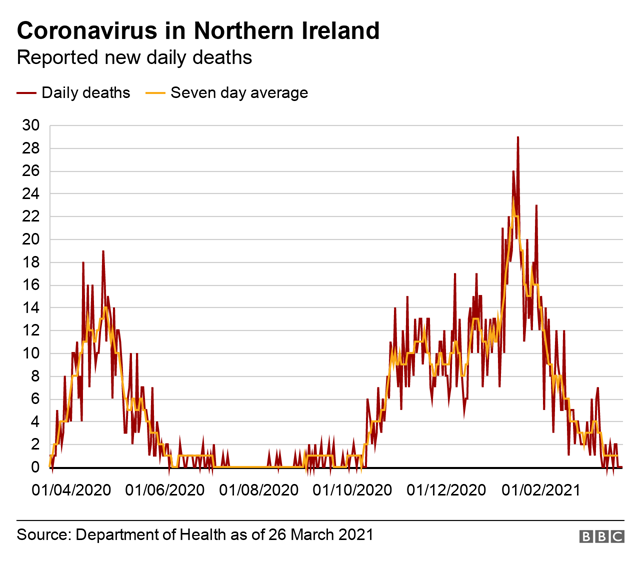

Covid-related deaths in Northern Ireland have fallen to quite a low level.
In the past week, there were five deaths - giving a seven-day rolling average of lower than one.
This is a similar rate to the end of September last year, before we entered the winter surge.
The number of deaths recorded by Nisra also fell for an eighth week in a row.
Over the entire pandemic, Northern Ireland's death rate has been lower than the rest of the UK and much more in line with the Republic of Ireland.
Northern Ireland has had 110 deaths per 100,000 population. That's in stark contrast to the rest of the UK - Britain's equivalent rate is 193 deaths 100,000.
The Republic has recorded 4,651 deaths giving it a rate of about 93 per 100,000 population.
It's worth noting that the Republic includes "probable" and "possible" Covid deaths in this number, meaning it is much more like Nisra's overall number, rather than the Department of Health's.
Nisra counts the number of death certificates on which the virus is mentioned, while the department uses deaths within 28 days of a positive Covid test.
Using Nisra's number - which allows for a clearer comparison with the Republic - Northern Ireland's death rate over the course of the pandemic is about 152 deaths per 100,000.
Infection rates
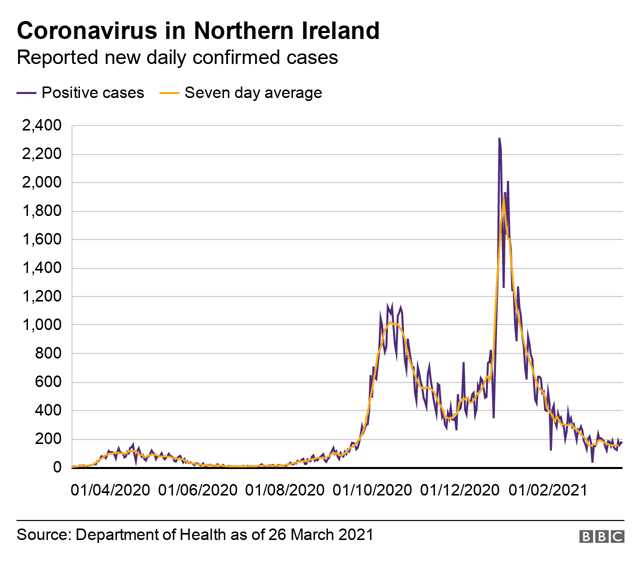

Northern Ireland's infection rate has been slowly falling.
According to stabilised data up until 21 March, the UK's overall infection rate is 57.7 cases per 100,000 population.
Northern Ireland's is 56.5, making it the second lowest in the UK after Wales (39.6).
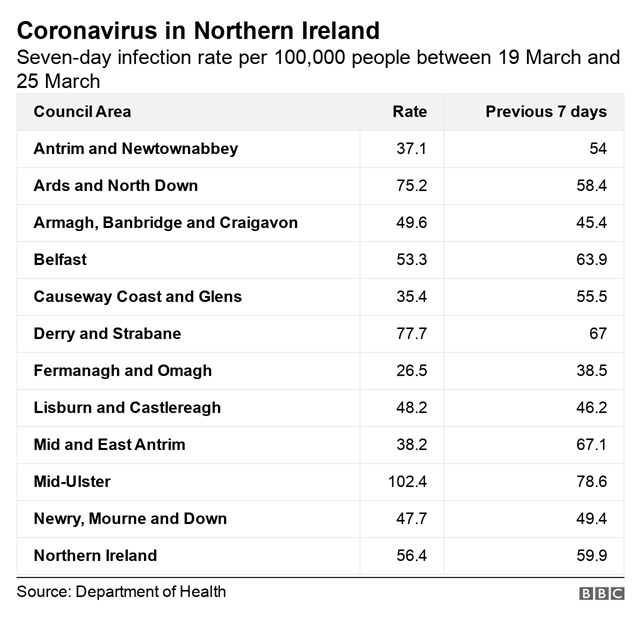

England's is marginally higher than Northern Ireland's, while Scotland has the highest infection rate in the UK at 71 cases per 100,000.
The rates are much lower than they were in January, but the speed of decline has slowed.
The Republic of Ireland does not publish an equivalent rate but it can be calculated from the case numbers. For the same period, up to 20 March, it was 77.3 cases per 100,000.
The Republic has seen an increase in infections in certain areas, most noticeably east Donegal, along the border.
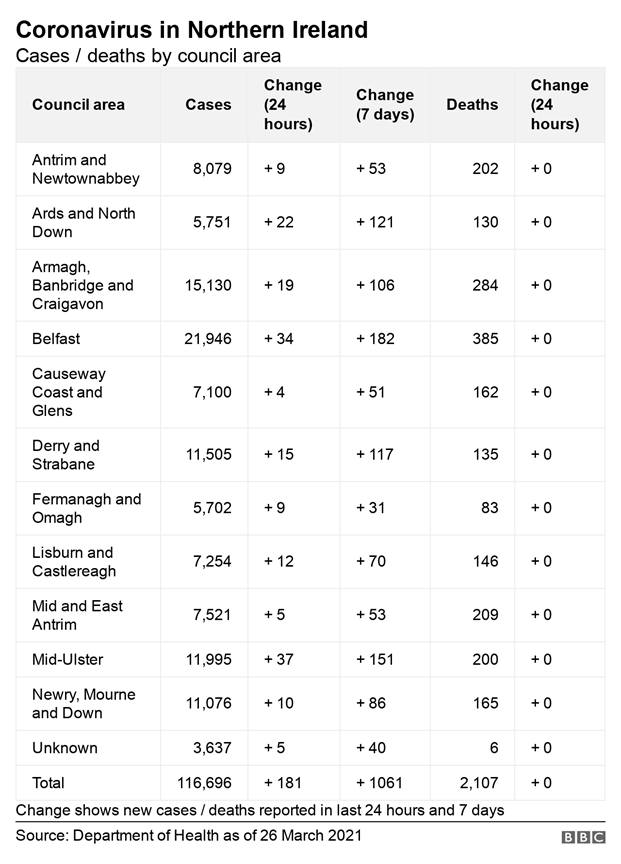

The Strabane area has seen a corresponding rise in cases and has been driving an increase in the recorded infection rate in the Derry and Strabane council area.
Mid Ulster has also seen an increase in its infection rate and now has the highest in Northern Ireland.
According to the latest estimate Northern Ireland's R number - the reproduction value for the virus - is between 0.75 and 0.95. This indicates that the spread of the virus is contracting.
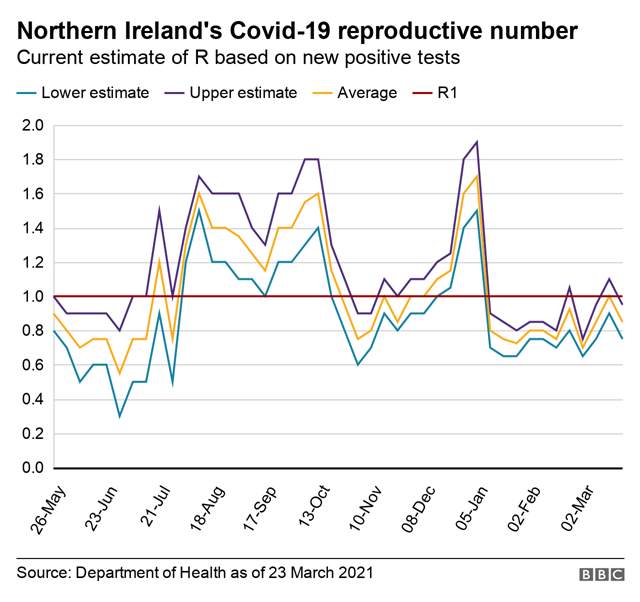

Testing
Recently, more and more people have been getting tested for Covid-19, but fewer and fewer have been testing positive.
Over the past week, the numbers being tested have been similar to what was seen at the peak of the winter surge.
However, back at the start of January more than one in four people were testing positive. Now it's more like one in 36.
Hospitalisations
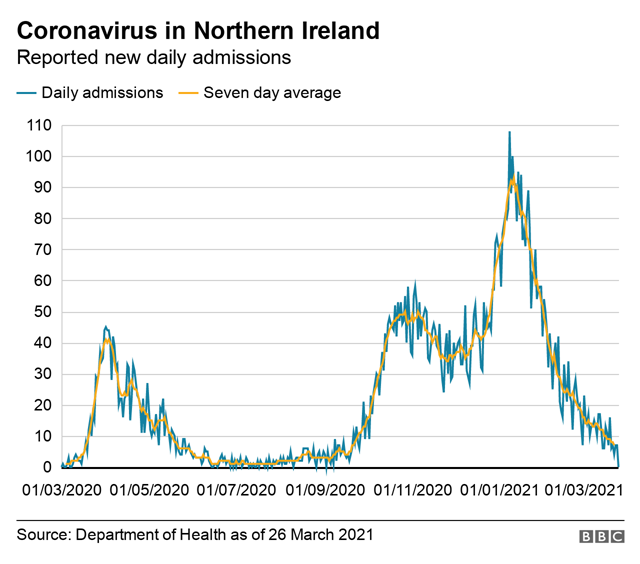

For the first time in almost six months, fewer than 150 people with Covid-19 are in Northern Ireland's hospitals.
This is not quite pre-surge levels but it does represent a huge drop from the height of the winter peak.
Over recent weeks the rate of decline of the numbers in hospital has slowed down, but crucially those numbers have continued to decrease.
And it's fair to expect them to continue to decrease - at least in the short term.
That's because hospital admissions have fallen to comparatively quite low levels, with about seven Covid patients per day being admitted to hospital.
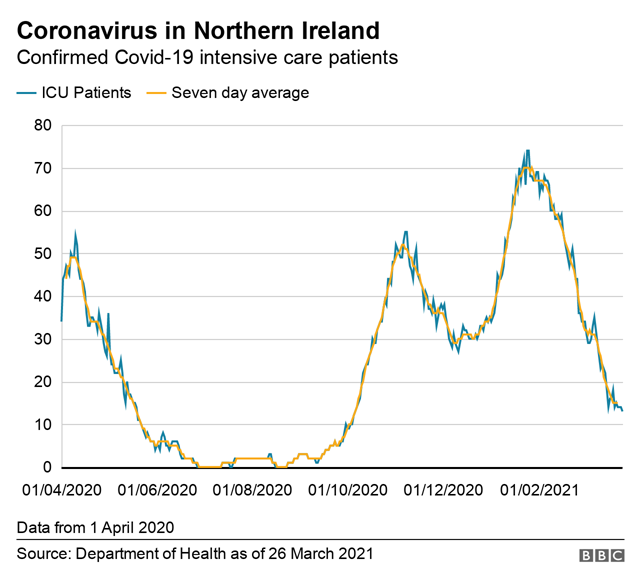

This lower patient number can also be seen in intensive care. Currently there are 13 patients with Covid in intensive care.
The number of Covid inpatients in intensive care has been fairly steady for some time now, with very slow decreases, but decreases nonetheless.
- Published20 February 2021

- Published26 March 2021
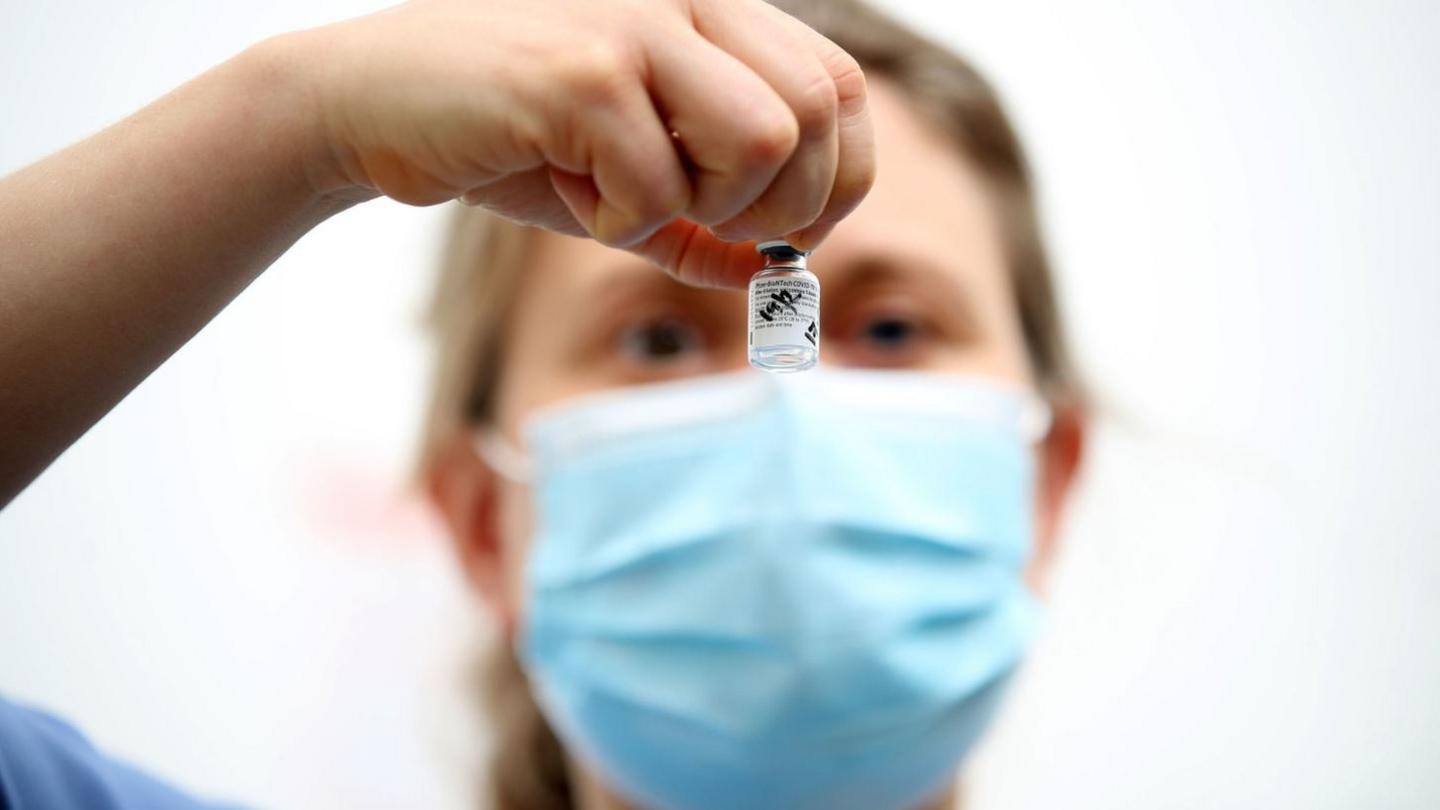
- Published26 March 2021
